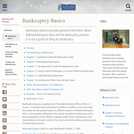
These short videos explain bankruptcy a legal process that provides relief to many individuals who can no longer pay all of their debts.
- Subject:
- Business and Communication
- Finance
- Material Type:
- Lecture
- Provider:
- U.S. Courts
- Date Added:
- 04/24/2007


These short videos explain bankruptcy a legal process that provides relief to many individuals who can no longer pay all of their debts.

Many people find themselves in financial trouble, but it is good to know there are options available should you need serious financial help. The April 2018 bonus edition of Page One Economics: Focus on Finance discusses earning income, budgeting, late payments, and collections. It introduces the basics of legal protection offered in the form of bankruptcy and describes some potential consequences of filing a bankruptcy case.
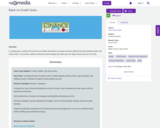
In small groups, students will research and obtain information to compare services offered and rates between banks and credit unions. To conclude, students will present their findings and state why one might choose one over the other.

Here you can find web lectures discussing different aspects of health systems thinking.The first lecture is about the WHO health system building blocks, outlining this theoretical framework compromising of Leadership/Governance, Health workforce, Medical technologies, Financing, Information and Service delivery.The second lecture gives a historical background to the development and thinking aboiut health systems, outlining the different approaches over the past decades.The third lecture is on health financing and how this can be organised.The web lectures can be used seperately or as a package. You will also find pdf-files with the correponding powerpoint presentations
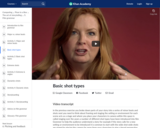
Overview of basic shot types.

Lesson Objective: At the completion of this lesson, students will be able to create a budget to accomplish personal financial goals.
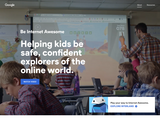
Teaches kids the fundamentals of digital citizenship and safety.

This guide walks you through the "Be Internet Awesome" Digital Citizenship games and curriculum created by Google for grades 2-6 (although older students might also enjoy the games). The games are extremely engaging and can be played on their own--or accompanied by their corresponding lessons. The lesson plans provide everything educators need to begin teaching this content in their classrooms

Students match tax types to definitions and then apply their knowledge to tax scenarios.
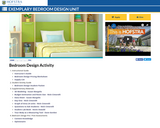
STEM focused lesson that incorporates hands on and computer based 3D design. Grade specific math concepts such as budgets, percentages, and square footage is applied.

A Beginner's Guide to Information Literacy covers the ACRL's Framework for Information Literacy frame by frame, using casual language and real world examples. Use this click-through text-based resource to understand the Framework as a whole or to work on understanding a particular Frame. Reflection questions are included for the casual learner or for anyone incorporating Information Literacy conversations into a classroom or workshop.

This guide covers each concept included in the Framework for Information Literacy for Higher Education, a document created by the Association of College and Research Libraries (ACRL). The goal of this guide is to break down the basic concepts and put them in accessible, digestible language so students can think critically about information and how we use it.
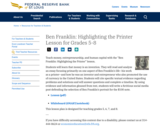
Students will learn that money is an invention. They will read and analyze an essay focusing primarily on one aspect of Ben Franklin's life his work as a printer and how he was an inventor and entrepreneur who also promoted the use of currency in the United States. Students will cite specific textual evidence regarding problems and solutions and will answer questions and complete a timeline. By using evidence and information gleaned from text, students will write a fictitious social media post defending the selection of Ben Franklin's portrait for the $100 note.

Tool Overview and worksheet

Inflation numbers are important economic indicators. But thinking beyond the numbers reveals a deeper reality. For example, how do businesses respond to inflation? Some resort to shrinkflation and skimpflation. Learn about these practices and their effects on consumers in the December 2022 issue of Page One Economics®: Focus on Finance.

Crypto assets have increasingly occupied news headlines and the minds of many consumers. While initially introduced as a payment system, crypto assets are seen by many as an enticing investment opportunity. This issue of Page One Economics® introduces crypto assets, blockchain technology, and the emerging crypto universe.
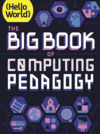
This special edition focuses on practical approaches to teaching computing in the classroom, and includes some of our favourite pedagogically themed articles from previous issues of Hello World, as well as a few never-seen-before pieces. It is structured around twelve pedagogical principles, first developed by us as part of our work related to the National Centre for Computing Education in England. These twelve principles are based on up-to-date research around the best ways of approaching the teaching and learning of computing.
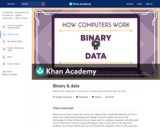
Adafruit founder Limor Fried and program manager Federico Gomez Suarez explain how computers represent numbers, text, images, and sound using tiny electric signals.

While many people have heard of Bitcoin, far fewer understand it. In short, Bitcoin is a digital currency that allows transactions independent of the banking system. Lately, many people are buying Bitcoin purely as a financial investment, hoping it will appreciate. So which is it—currency or financial asset? Read more about it in the March 2018 issue of Page One Economics.

Cryptocurrencies like Bitcoin rely on blockchain technology and crypto mining, which consume massive amounts of electricity and have significant carbon footprints. The lack of transparency and regulation in the industry raises concerns about the economic, social, and environmental costs associated with crypto mines.